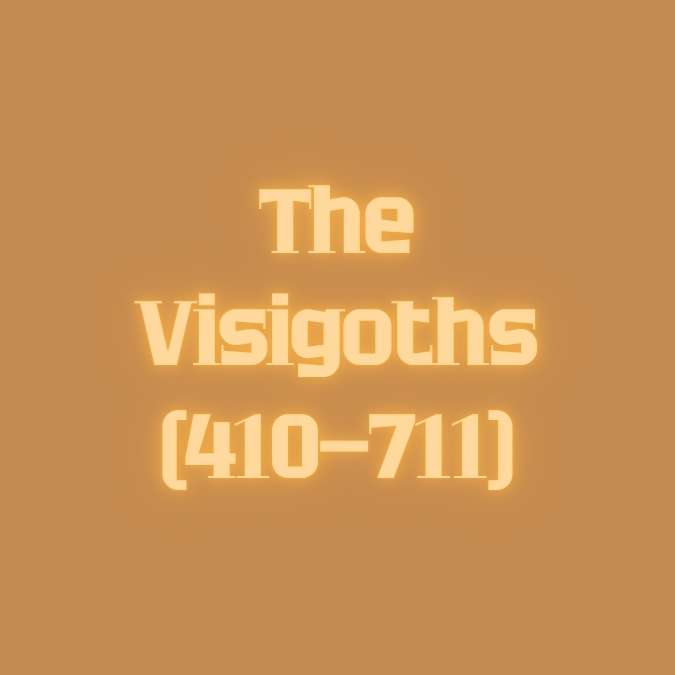
The story of the Visigoths, one of the most influential Germanic tribes in European history, is a tale of transformation — from fierce warriors who sacked Rome to founders of a Christian kingdom that would shape medieval Spain. Between 410 and 711 AD, the Visigoths carved out a realm that bridged the fall of the Roman Empire and the rise of medieval Europe. Their legacy lives on in Spain’s language, laws, religion, and even its sense of identity.
This article explores who the Visigoths were, how they rose to power, what made their kingdom thrive, and why it eventually fell — all explained in a clear and engaging way to help you truly understand this fascinating period in history.
🏹 Origins of the Visigoths: From the North to the Roman World
The Visigoths were part of the larger Gothic people, a Germanic group that originally lived near the Baltic Sea, in what is now Poland and southern Scandinavia. Around the 3rd century AD, the Goths began migrating southwards toward the Roman Empire’s borders.
The Goths eventually divided into two main branches:
- The Ostrogoths (“Eastern Goths”)
- The Visigoths (“Western Goths”)
The Visigoths first appeared in Roman history around the late 3rd century, when they began to raid Roman territories along the Danube River. Over time, they were drawn into the Roman world — not only as enemies but also as allies, settlers, and eventually as rulers.
⚔️ The Battle of Adrianople (378): A Turning Point
One of the most significant moments in Visigothic history was the Battle of Adrianople in 378 AD. The Visigoths, led by Fritigern, rebelled against Roman mistreatment after being allowed to settle within the empire.
At Adrianople, they crushed the Roman army and killed the Emperor Valens, shocking the Roman world. This battle marked the beginning of the decline of Roman military supremacy and showed that the empire could no longer control the powerful tribes on its borders.
After Adrianople, the Visigoths roamed the Balkans, alternately fighting and negotiating with Rome. Their relationship with the empire became increasingly complex — both hostile and dependent.
🏛️ Alaric I and the Sack of Rome (410): A Symbolic Earthquake
Perhaps the most famous Visigothic leader was Alaric I, whose name is forever linked to one of the most dramatic events in history — the Sack of Rome in 410 AD.
Alaric, frustrated after years of being denied fair treatment and payment for his troops, decided to march on the Eternal City. The Visigoths entered and plundered Rome, a city that had not fallen to a foreign enemy in nearly 800 years.
Although the sack was relatively restrained compared to later destructions, it had an enormous psychological impact. To the Roman world, it felt like the end of civilization. To the Visigoths, however, it was the beginning of a new chapter — one that would lead them to create their own kingdom.
🚶 From Italy to Gaul and Hispania: The Journey of a People
After Alaric’s death in 410, the Visigoths continued their migration under his successors. They first settled in southern Gaul (modern-day France). By 418, the Roman authorities, desperate for allies, allowed the Visigoths to settle officially in Aquitaine, with their capital at Toulouse.
This arrangement, known as foederati status, meant the Visigoths served as federated allies of Rome — protecting the region in exchange for land. From this base, they gradually expanded their power, becoming the dominant force in southwestern Gaul and the Iberian Peninsula (Spain and Portugal).
👑 The Kingdom of Toulouse: The First Visigothic Realm
The Visigothic Kingdom of Toulouse (418–507) was the first stage of Visigothic rule in Western Europe. It was here that the Visigoths began to transform from a nomadic warrior people into rulers of a settled, organized kingdom.
Under kings like Theodoric I and Euric, the Visigoths:
- Strengthened their political control over Gaul and Hispania
- Created administrative systems inspired by Roman models
- Began writing down their laws and customs, blending Gothic and Roman traditions
King Euric (466–484) was particularly important — he was the first Visigothic ruler to declare full independence from Rome. His Code of Euric became one of the earliest written Germanic legal codes, showing the tribe’s growing sophistication and stability.
⚖️ The Visigoths and Roman Law
One of the most fascinating aspects of Visigothic culture is how they preserved Roman law while also developing their own traditions.
The Visigothic Code (also known as the Liber Iudiciorum, completed in the 7th century) was a remarkable achievement — a comprehensive legal system that applied to both Visigoths and Hispano-Romans.
It covered everything from property rights and marriage to crime and punishment. Its goal was to create a single, unified legal framework, symbolizing the merging of two worlds: the old Roman civilization and the new Gothic order.
This legal legacy endured long after the fall of the Visigothic kingdom, influencing medieval Spanish law for centuries.
✝️ Religion: From Arianism to Catholicism
Religion played a central role in Visigothic identity and politics. Like many Germanic tribes, the Visigoths initially followed Arian Christianity, a form of the faith that denied the full divinity of Christ.
This belief set them apart from their Catholic Roman subjects, creating religious tension within the kingdom.
Everything changed under King Reccared I, who in 589 AD, converted to Catholicism at the Third Council of Toledo.
This monumental decision:
- Ended centuries of division between Visigoths and Hispano-Romans
- Strengthened the monarchy’s authority
- Unified the kingdom under a single faith
The conversion was a turning point that helped solidify the Visigothic identity as Christian rulers, paving the way for Spain’s deep Catholic roots in later centuries.
🏰 The Kingdom of Toledo: The Heart of Visigothic Power
After losing most of their territory in Gaul to the Franks in 507 AD, the Visigoths moved their capital to Toledo, in the center of the Iberian Peninsula.
From Toledo, the Visigothic kings ruled a vast and diverse realm that covered most of modern-day Spain and Portugal.
The Kingdom of Toledo (507–711) became one of the most important political and cultural centers in post-Roman Europe. It combined:
- Roman administrative traditions
- Germanic military strength
- Christian faith
- A growing sense of unity and identity
The Councils of Toledo, gatherings of bishops and nobles, became crucial political institutions that helped govern the kingdom. These councils also shaped early medieval ideas about church-state cooperation.
🧭 Society and Culture: A Blend of Two Worlds
Visigothic society was a fusion of Gothic and Roman traditions. While the ruling elite maintained Gothic names and customs, most of the population was Roman in language, culture, and religion.
Key features of Visigothic society included:
- A warrior aristocracy, loyal to the king but often prone to rebellion
- An agrarian economy, based on land ownership and farming
- A patriarchal family system, influenced by both Roman and Gothic law
- Latin as the dominant language, with Gothic gradually disappearing
Visigothic art and architecture, though less monumental than Roman works, displayed a unique mix of Christian symbolism and Germanic design, as seen in their churches and jewelry.
⚰️ The Decline and Fall of the Visigothic Kingdom (7th–8th Century)
By the late 7th century, the Visigothic kingdom faced deep internal problems.
Frequent power struggles, noble revolts, and succession disputes weakened royal authority. The monarchy was not hereditary — kings were elected by nobles, leading to constant plots and instability.
In 711 AD, disaster struck. The Muslim forces from North Africa, led by Tariq ibn Ziyad, crossed the Strait of Gibraltar and defeated the Visigothic army at the Battle of Guadalete.
King Roderic, the last Visigothic ruler, died in battle. Within a few years, most of the Iberian Peninsula fell under Islamic control, marking the end of Visigothic rule and the beginning of al-Andalus.
🌅 Legacy of the Visigoths
Although their kingdom vanished, the Visigoths left a lasting mark on European and Spanish history.
Their legacy can be seen in:
- 🏛️ Spanish law, influenced by the Liber Iudiciorum
- ✝️ Catholic tradition, reinforced by Reccared’s conversion
- 🗡️ The concept of a unified Christian Spain, later revived during the Reconquista
- 🧱 Archaeological remains, such as Visigothic churches and treasures like the Guarrazar Hoard
The Visigoths were more than barbarian invaders — they were builders of a new civilization, bridging the fall of Rome and the birth of medieval Europe.
🕊️ Conclusion: The Visigoths and the Shaping of Europe
Between 410 and 711 AD, the Visigoths evolved from wandering warriors to nation-builders, leaving behind a kingdom that would shape Western civilization.
Their story is one of adaptation, transformation, and legacy — a people who began as outsiders to the Roman world but ended up preserving and renewing its traditions.
The Visigoths remind us that history is not simply about destruction or conquest — it’s about how cultures merge, evolve, and endure. Their kingdom may have fallen, but their influence still echoes in the heart of Spain and in the very foundations of Europe. 🇪🇸✨
Sources:
- Collins, Roger. Visigothic Spain, 409–711. Blackwell Publishing.
- Heather, Peter. The Goths. Blackwell Publishers.
- Thompson, E.A. The Goths in Spain. Oxford University Press.
- Encyclopaedia Britannica (updated 2025).
- The Metropolitan Museum of Art: Visigothic Art and Artifacts Collection.

